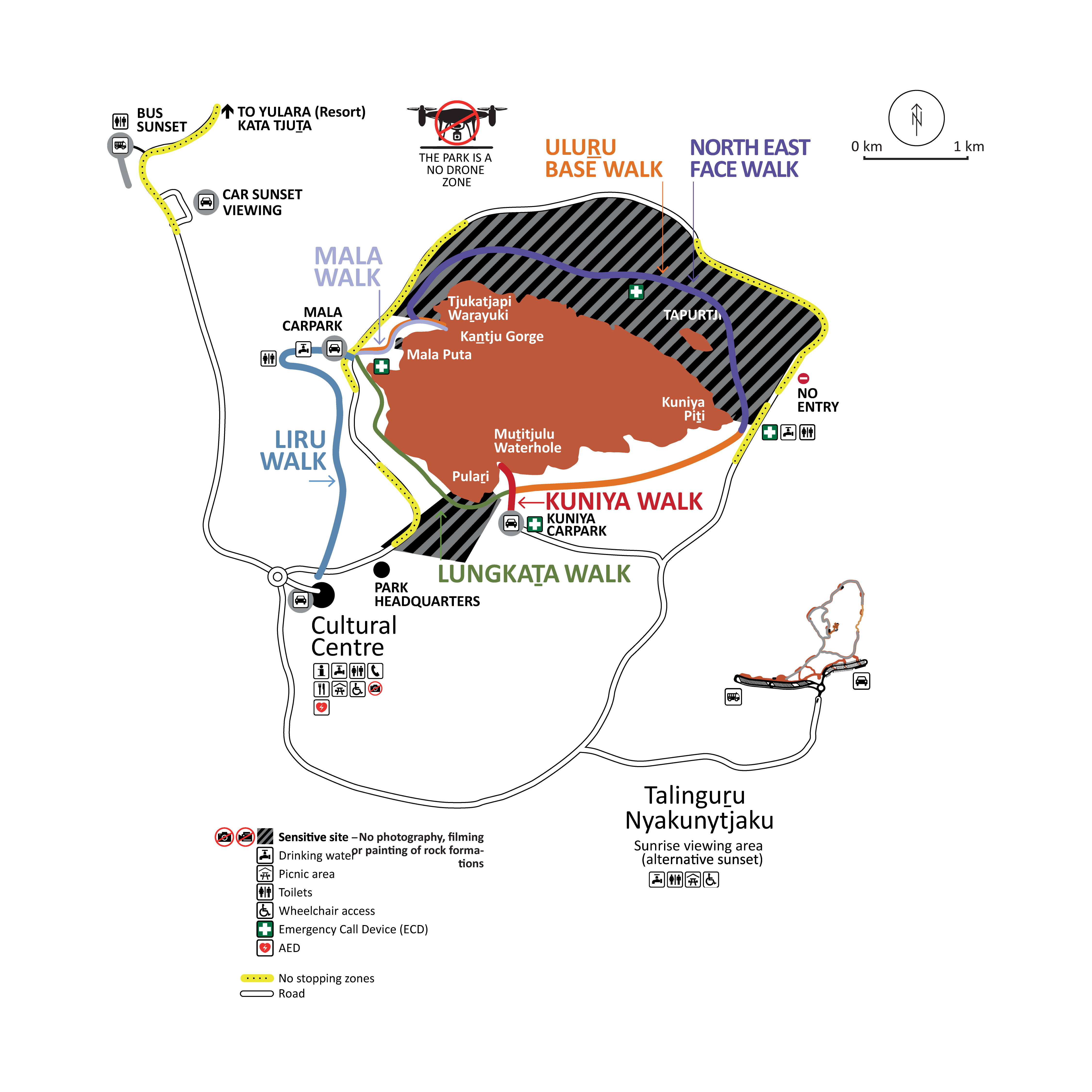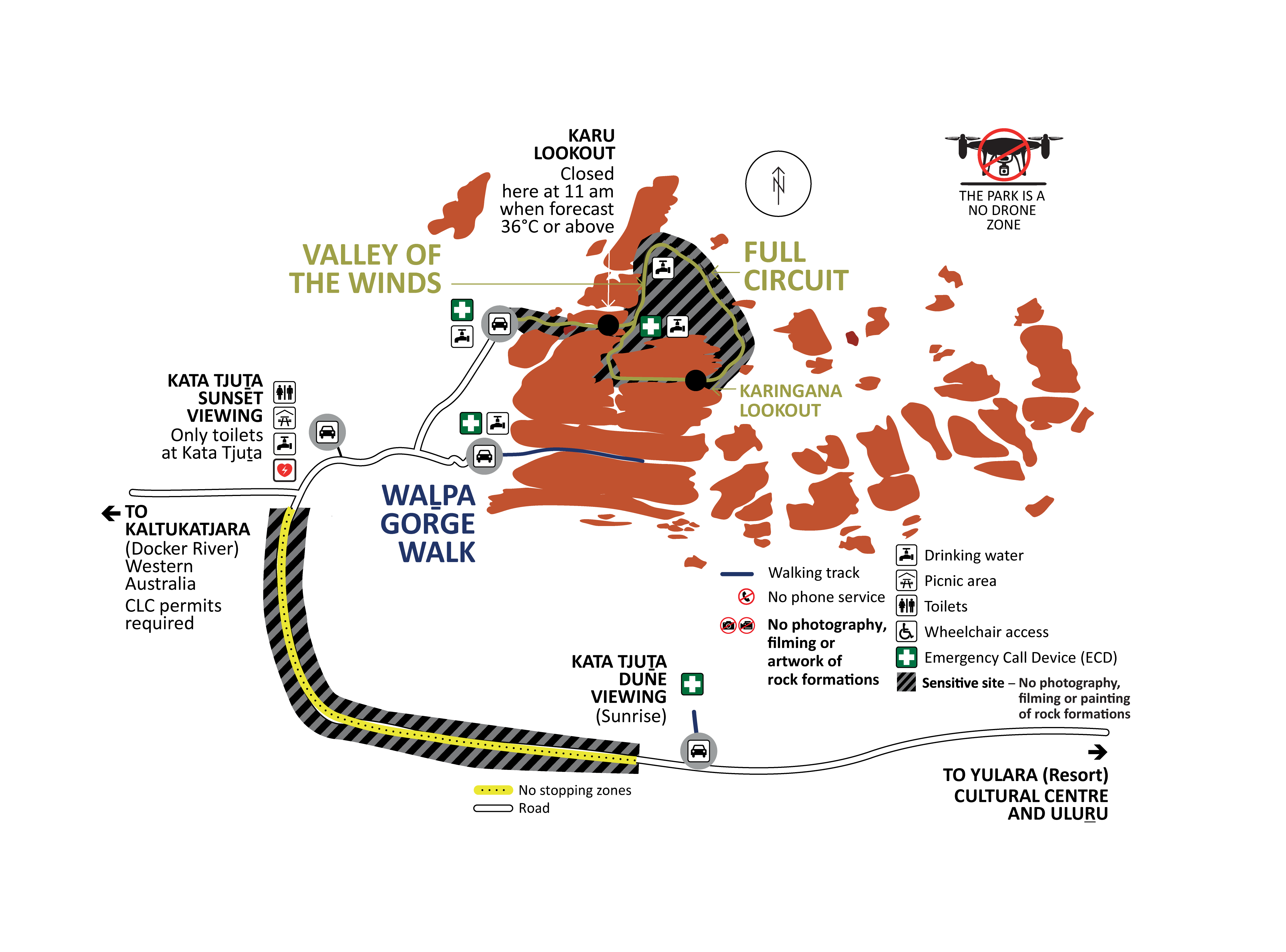Photography
Uluru is one of the most photographed landmarks in Australia, and it’s easy to see why.
But the park has plenty of photo opportunities beyond Uluru: sweeping landscapes, breathtaking geological formations, delicate wildflowers and the Milky Way twinkling in the night sky.
Uluru and Kata-Tjuta change colour and appearance depending on the angle, weather and time of day. The rock can appear moody on overcast days, shiny when it’s wet and glowing red at sunset. You’re guaranteed spectacular shots whenever you visit.
General photography tips
- If you’re an enthusiastic photographer or videographer, you’ll want to bring your best quality lenses and a sturdy tripod. Make sure you pack some cleaning cloths and blowers to keep the sand off your equipment.
- Stay on marked walking tracks and within authorised areas at all times.
- Always follow the road rules. If you want to photograph from the side of the road, make sure you park where there are white lines.
- Check out our walks and sunrise and sunset sections to get detailed tips for some of our most popular photo locations.
Cultural protocols for photographers
Uluru and Kata Tjuta have a number of culturally sensitive sites. The rock details and features at these sites are equivalent to sacred scripture for Anangu – they describe culturally important information and should only be viewed in their original location and by specific people.
It is inappropriate for images of sensitive sites to be viewed elsewhere, so taking any photos of these places is prohibited.
But don’t worry – culturally sensitive sites in the park are quite spread out, giving you plenty of opportunities to take amazing photos while respecting Anangu culture.
Download our photography brochure.
Identifying sensitive areas
The maps show locations of sensitive sites and areas where Anangu ask that you do not photograph Uluru or Kata-Tjuta. This creates the perfect opportunity to immerse yourself in the environment and cultural landscape that surrounds you. Throughout sensitive areas, you are welcome to take images of flora, fauna and people while ensuring that you avoid capturing any rock formations.
Culturally sensitive sites are also clearly identified by signs in the park.
 Culturally sensitive sites at Uluru
Culturally sensitive sites at Uluru
 Culturally sensitive sites at Kata Tjuta
Culturally sensitive sites at Kata Tjuta
Photographing the north-east face of Uluru
Running from Kantju Gorge to Kuniya Piti, the north-east face of Uluru is one of the park’s most sensitive areas.
This is the side of the rock most commonly seen from Ayers Rock Resort, the Camel Farm, Field of Light, Sounds of Silence, Longitude 131 and when flying in or out on a commercial flight.
Given the north-east face’s great cultural significance, Anangu ask that photographers only take wide shots from a distance and avoid showing any of the details on the top-left side of the rock.
The best time to take photographs of the north-east face is 1–2 hours before sunset, when naturally occurring shadows obscure the sacred sites. Not only will you be respecting Anangu culture, you are also guaranteed a fantastic shot that combines light and shade.
Alternatively, you can block out the sacred sites with an object such as a tree, bush, sand dune, person, or even a camel! You can use similar tricks to avoid photographing other sensitive sites around Uluru.
Taking photos of Anangu
Like most people, Anangu don’t like to be filmed or photographed without permission. Before taking any photos of Anangu, ask them if they’re happy for you to do so.
Media handbook
Our media handbook describes how to capture video and images of the park while respecting Anangu cultural values.
The handbook is targeted at media and other professionals but has plenty of handy tips for the amateur photographer.
Commercial photography
If you want to use photos or videos of the park for commercial purposes or public display (including influencers, bloggers, artists and content creators) you will need to apply for a media permit and follow our media guidelines.
Drone use
Drones and other remote controlled devices are prohibited in Uluru-Kata Tjuta National Park under the Environment Protection and Biodiversity Conservation (EPBC) Act. Penalties apply for unauthorised use, so please do not attempt to use a drone for filming or photography.
Taking photos of plants and animals
 The thorny devil is a popular subject for photographers
The thorny devil is a popular subject for photographers
Uluru-Kata Tjuta National Park has five seasons. Each season offers different opportunities for photographing plants and animals.
A breathtaking vista of desert wildflowers blooms in the piriyakutu/piriya piriya season – but only after winter rains. Summer rains cause the park’s vast seas of native grasses to grow tall, making for many fantastic shots.
Whenever you visit, please minimise your environmental impact by not disturbing flora or fauna. Don’t break off any branches or venture into the bushes to get a close up. For your safety and the protection of our wildlife, we ask all visitors to refrain from touching or handling wildlife in the National Park.
If you don’t have ideal climatic conditions during your visit, you can still get fantastic close-ups of plants in Ayers Rock Resort, outside the national park. The resort’s landscapers work year-round to grow flora that appears only seasonally in the park.
Astrophotography
Central Australia is a superb place to photograph the night sky, and the silhouette of Uluru against the Milky Way has become an iconic Australian shot.
However, all visitors need to exit the national park by closing time. That means that any night-sky shots have to be taken from outside the park.
A great spot for astrophotography is an elevated lookout on top of a sand dune beside the Lasseter Highway, about halfway between the park entry station and Ayers Rock Resort. Other lookouts around the resort area offer good alternatives.
Taken a great shot?
We’d love to see your amazing snaps of the park! Please share your photos on Instagram and tag them with #SeeUluru.
